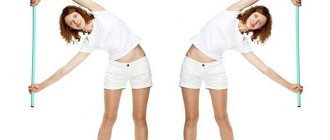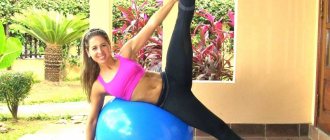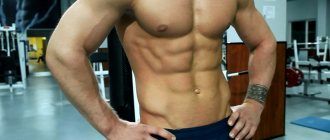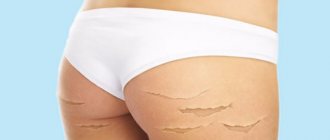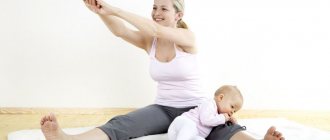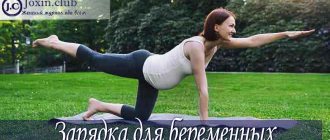The birth of a child is a happy event in life for any woman, but after a while the woman thinks about how to quickly get in shape. It is quite difficult to immediately return to your previous form, this is due to many factors: hormonal levels are being adjusted, a young mother no longer has as much time for herself as before. However, if a woman who has given birth wants to achieve quick results and bring her body back to normal without harming the body, she should consider a set of exercises on a fitball for losing weight after childbirth.
Features and selection
Fitball is a large elastic rubber ball of various diameters and colors. For many years he has been helping young mothers get in shape. Such exercises are safe, effective, and also help the body adapt to further, more serious training.
To achieve the greatest effect, and so that aerobic exercise does not cause harm to health, you need to choose the right equipment.
The main guideline when choosing a sword is your height. There are certain standards that will help you choose the optimal size. For short girls (height up to 156 cm) - a ball with a diameter of 55 cm, of average height (156-174 cm) - 65 cm. For tall women from 175 cm, balls with a diameter of 75 cm are suitable. If a woman is very tall, from 185 cm with a ball diameter should be 85 cm.
Scientists and doctors have found that moderate and proper physical activity is beneficial for both the expectant mother and her baby.
A smooth rubber ball or a classic bulky ball is an excellent choice for mom. Who plans to study with the baby. Pimply ball - will help cope with cellulite. A ball with one or two handles is intended for those who have no experience with the ball and also have poor balance.
Smooth fitballs have medium hardness and are suitable only for exercises, while pimply ones, due to their increased rigidity, affect not only the muscles, but also the quality of the skin due to the massage effect.
- In addition, it is important to consider a number of features:
- Consultation with a doctor. Before starting training, consult a gynecologist, who, after an examination, will decide whether you can start training.
- Choosing the right clothes that will not restrict movement is also an important point.
- Choosing a training room. The floor in the room where classes will take place must have a smooth, even surface. The room needs to be ventilated and cleared of foreign objects.
- All exercises must be performed smoothly, sudden movements are not allowed. Watch your breathing.
- The right time to study. If the mother plans to study alone, then the ideal choice would be the baby's bedtime. If classes will be carried out with the baby, then the appropriate time is before feeding.
Why fitball?
For more than 30 years, the big, bright ball has helped millions of postpartum women get into and even improve their prenatal shape. Fitball is often used for successful rehabilitation after injuries and operations, because exercises on it are safe and effective for people of all ages.
The ball will help prepare your body for further training if you plan to go to the gym or run in the future. If you choose the optimal and safe sport while breastfeeding, then fitball is ideal (find out about other suitable sports in my detailed post).
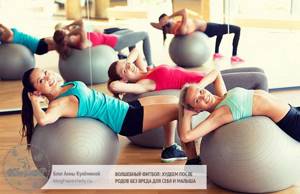
A properly selected set of exercises will help:
- strengthen the back and abdominal muscles;
- improve coordination of movements;
- awaken every muscle, relax it or tone it;
- train your joints;
- give the body flexibility;
- gain a sense of balance;
- recharge with vital energy;
- improve mood.
Read about other ways to quickly regain your figure after childbirth.
Benefits and contraindications
The main goal of exercise after childbirth is to put your body in order. In addition, gymnastics using a fitball brings variety to the life of a young mother, has a positive effect on her mood, thereby helping to cope with depression after childbirth.
Benefits of gymnastics:
- Natural postpartum tummy tuck
- Restoring the tone of the abdominal, pelvic, and vaginal muscles.
- Fight cellulite.
- Tightening of the pectoral muscles.
- Normalization of blood circulation.
- Launch of metabolic processes.
The benefits of exercising on a ball are obvious, however, you need to remember to be aware of contraindications to exercising.
Contraindications:
- Injuries and ruptures during childbirth.
- Caesarean section (in this case there is a separate set of exercises).
- The presence of certain chronic diseases.
When can I start classes?
There are approximate recommendations for how long after giving birth you can start exercising. You can follow these recommendations only after visiting your doctor.
If a woman gives birth independently and without complications, then classes can begin in two months. After a non-independent birth, classes are allowed at best after six months.
For breastfeeding women, it is best not to exercise while your baby is breastfed. Often, even the simplest physical activity can reduce milk production, even to the point of loss.

Fitball is an excellent sports equipment that is suitable for expectant mothers with absolutely any level of physical fitness.
Fitball exercises after childbirth
Before starting classes, you need to assess the woman’s condition, her level of preparedness and physical characteristics. You need to train daily, at least 20 minutes per approach. Regular training will help you achieve the desired results very quickly. Below are examples of exercises and the technique for performing each of them.
Warm-up is where any activity should begin. Thanks to proper warm-up, the body is prepared for further work.
Inhale deeply, clasp your hands and stretch upward, then, as you exhale, lower your hands and lean forward. While warming up, walk in one place.
Leg raises
This exercise is designed to work the lower body.
- Sit on a fitball.
- Stretch your legs and spread them apart.
- Smoothly raise your legs up and stay in this position.
- Without touching the floor, slowly lower your legs down.
Reverse crunches on a fitball
An exercise that allows you to feel the pelvic muscles and abdominal muscles.
- Lean your back on the projectile.
- Press your feet to the floor.
- Cross your arms over your chest or behind your head.
- Use your upper body to lift yourself off the fitball, squeezing your buttocks.
- Take your starting position.
Twisting can be straight or lateral. Designed to work the longitudinal and transverse abdominal muscles.
Raising the pelvis with feet on a fitball
Lifting ups will help strengthen your gluteal muscles by increasing their elasticity.
- Lying on your back, rest your feet on the ball.
- Place your arms along your body, spreading them slightly to the side.
- Place your shoulder blades on the floor and your feet on the projectile.
- Slowly raise your hips and hold this position for a while.
- Return to the starting position.

When choosing a fitball, pay attention to its quality. A pronounced odor, stains, uneven seams, material that is unpleasant to the touch - all this should alert you.
Squat with fitball
When performing the approach, the gluteal and calf muscles are involved, and the ball massages the back.
- Lean on the ball, placing it between your lower back and any support (for example, a wall)
- Take a couple of steps away from the support.
- Squat until your thighs are parallel to the floor.
- Hold the squat position for 20 seconds.
- Take your starting position.
Jumping on the ball
A fairly simple but effective exercise that allows you to keep your abs and thighs toned. To perform this, it is better to buy a ball with handles.
- Sit on a fitball, legs are at right angles, back straight.
- Holding the handles on the ball, start jumping.
Ball lifts
- Lying on your back, wrap your legs around the apparatus.
- Smoothly lift your legs without releasing the ball.
- Keep your legs parallel to the floor.
- Slowly begin to lower your legs.
- Stay in this position for 15 seconds.
- Lower your feet to the floor.
Spring
When performed correctly, the abdominal muscles actively work, and the stomach gradually tightens.
- Lie on the ball with your stomach down.
- Bring your legs together.
- Place the projectile under your feet.
- Place your hands on the floor.
- Pull your knees towards your chest.
- Take your starting position.
- Perform the exercise at least 20 times.
- Remember to keep your back straight.
How to choose a ball and when to start?
Here the recommendations of doctors differ. Domestic ones “release” a young mother for training only after 2 months after a natural birth and 12 weeks after a cesarean section. Americans determine the speed of recovery individually. Has the uterus contracted? Welcome to the gym, fortunately, in the USA there is such a coaching specialization as postnatal fitness. Trainers with such diplomas know exactly how to train intensely enough and how not to cause harm. “Before” they prescribe special postpartum gymnastics without fitballs, consisting of only static contractions.
The ball is easy to select. Take your height and subtract 100. This is the approximate diameter of the ball. But you should round up. Let’s say, if we are a good 170 cm tall, and don’t have a 70 cm ball at hand, it’s worth taking not 65, but 75. To “pair” a fitball for home exercises, it’s a good idea to buy a set of rubber shock absorbers of various resistances to further strengthen the muscles.
When should you not exercise on a fitball to lose weight after childbirth?
If the recovery has not yet completed. You shouldn't use it if you've never really seen it before. This is unstable equipment, mastering which on your own is fraught with falls and loss of balance. It is good for a beginner to start under the guidance of a coach. But since in our country a young mother often finds herself locked at home alone with her child, we can consider alternative options.
First, learn how to do simple push-ups, planks and squats with lunges without fitballs or any weights. Gradually introduce the ball into your training, start with simple movements, for example, static squats against a wall with your back resting on the ball, and progress to more complex ones.
For weight loss needs, it is better to use diet rather than excess cardio. Even if you are breastfeeding, a slight deficiency will not affect milk production, but it will very much affect the quality of your body. In general, fitball training is developmental and general strengthening in nature.
What problems are not solved by such activities?
often girls say that they want to pump up round buttocks, this cannot be achieved if you do not work with the “iron”. However, setting just such a goal for the first six months after giving birth is too ambitious. “Mass” workouts are usually voluminous and intense at the same time, and you definitely can’t get by with balls; you need barbells of approximately your own weight on your shoulders. To reach this level of preparation, you need to sleep normally. And young mothers know that at first this is not entirely realistic. Exercises on a fitball for weight loss after childbirth cannot even change the proportions - widen the back, visually narrow the waist, help give the figure an athletic shape.
In general, when you exercise on a stability ball, you will look like just a more toned version of yourself, but the health bonuses are huge. Endurance will increase, your emotional state will level out, and recovery will go even faster.
Fitball exercises that you can do after childbirth
Attention! You should discuss issues with squats, jumps and lunges individually with your doctor. Only he knows whether you are allowed to do a deep squat or not yet, and only he can assess the safety of the impact load for you.
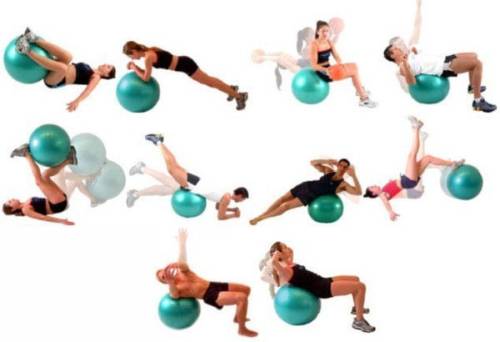
Full body fitball workout
Warm up . We stand up straight, the ball is in straight, lowered hands. For 10 minutes we take steps from side to side, swinging the ball forward and to the sides. It is best to count 10 swings and change direction.
Main part
Static squat against the wall. We stand with our back to the wall, place the ball under the lower back, and perform a squat. We hold the position of the thighs parallel to the floor for 30-60 seconds. 4-5 approaches
Glute bridge on the ball. We lie on the floor, feet on the ball, lift the pelvis with a bridge, statically contracting the back of the thighs. 10-12 repetitions in 3-4 sets
Leg curl with ball. Lie on your stomach with the ball between your feet. Bend your knees until they are perpendicular and gently lower them down. 10-12 reps, 3-4 sets
Extension with the ball. Lie on your back with the ball between your feet. We lower it to the buttocks and raise it only due to extension in the knee joint. 10-12 repetitions, 3-4 approaches
Press
Toe strap. We stand in a plank position, toes on the ball, stand for 30-60 seconds, 3-4 approaches
Reverse twist. Without changing the initial position, we roll the ball to the stomach by contracting the abs. Arms in support, movement in the shoulder joints is minimal. 15-20 reps, 3-4 sets
Straight twist. We lie on the ball with our backs and pull the lower ribs towards the pelvic bones. Maintaining stability by opening your legs
Back
"Flight". We lie down with our stomachs on the ball and spread our arms in the letter T. We move our hands up and down by bringing the shoulder blades towards the spine. Repeat 10-12 times, 3-4 approaches
Tilts. The ball is in straight outstretched hands. We stand straight, due to flexion in the hip joint, we lower ourselves as low as possible to the floor and rise for 12-15 repetitions. 3-4 approaches.

Complete the exercises on the fitball (for weight loss after childbirth) with the number of push-ups available to you with your toes on the ball or just in a regular lying position. This will allow you to work your chest and arms. Work with this plan for about 3-4 weeks, and then add strength exercises with weights or resistance (rubber shock absorbers) to your program.
After caesarean section
It is quite difficult to return the body to its previous shape after a caesarean section. Firstly, for medical reasons, many women are prohibited from engaging in physical activity and are required to undergo physical rest for the first six months. But the longer a woman lives without physical activity, the harder it is for her to get back into shape. Therefore, as soon as the doctor has given permission to switch to activity, you need to immediately start exercising. Due to the fact that women who have had a cesarean section are susceptible to depression and get tired faster, it is recommended to start training with simple exercises. They will prepare the body and muscles, and in the future will provide the opportunity to move on to more complex loads. If the exercises involve stress on the abdomen, it is better to wait until the postoperative scar is completely healed, as there is a possibility of suture divergence.
After natural childbirth
It is much easier for women who give birth on their own. In the absence of any serious complications, you can begin performing a set of exercises within a couple of months. Of course, it is important to take into account the woman’s well-being. If everything is in order, she feels a surge of energy, and there are no contraindications, you can start training. It is better to start exercising gradually, evenly distributing the load on all muscles. After some time, the body gets used to regular training, and then a transition to more serious exercises is possible. A popular exercise is the plank. There are several options for its implementation:
- lying on your stomach on the apparatus, with your feet on the floor, hands behind your head;
- leaning on the ball, keep your body in a horizontal position, resting your elbows on the floor and your toes on the ball;
- The reverse plank is performed with your back down. Place your hands on the floor and place your feet on the ball.
Whatever version of the plank you choose, remember, the body should not bend. If you perform the exercise correctly, from the first seconds you will be able to feel every muscle in your body.
Fitball exercises effectively help you fight excess weight and lose weight well. Mostly all young mothers face this problem. Such exercises work well in combination and in combination with other methods that help get in shape. If a woman adheres to the principles of proper nutrition and also performs physical activity daily, the result will not be long in coming.
Tips for choosing a ball
Correctly selected equipment is the key to quick results, comfortable, enjoyable training. A large ball will not allow you to fully perform the exercises, since the person will constantly slide out of it. A small one will put increased stress on the legs and will begin to slip away from under the person.
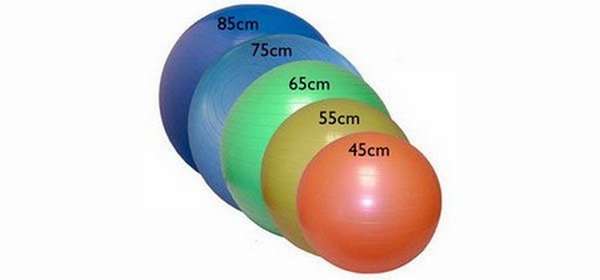
To determine the optimal size and shape of the ball, you need to do the following:
- You need to sit on the ball and straighten your back. The angle of the legs relative to the floor should be 90 degrees.
- Feel the elasticity of the ball. It should not resist the weight too much, but it is also undesirable for it to bend excessively.
- Each ball is made to a specific diameter. The calculations are based on growth. There are certain standards for choosing the right ball.
| Ball diameter, cm | Height, cm |
| 45 | Less than 150 |
| 55 | 150-165 |
| 65 | 165-180 |
| 75 | 180-200 |
| 85 | Over 200 |
Balls can have ears, handles, or spikes for massage. You can choose at your own discretion.
